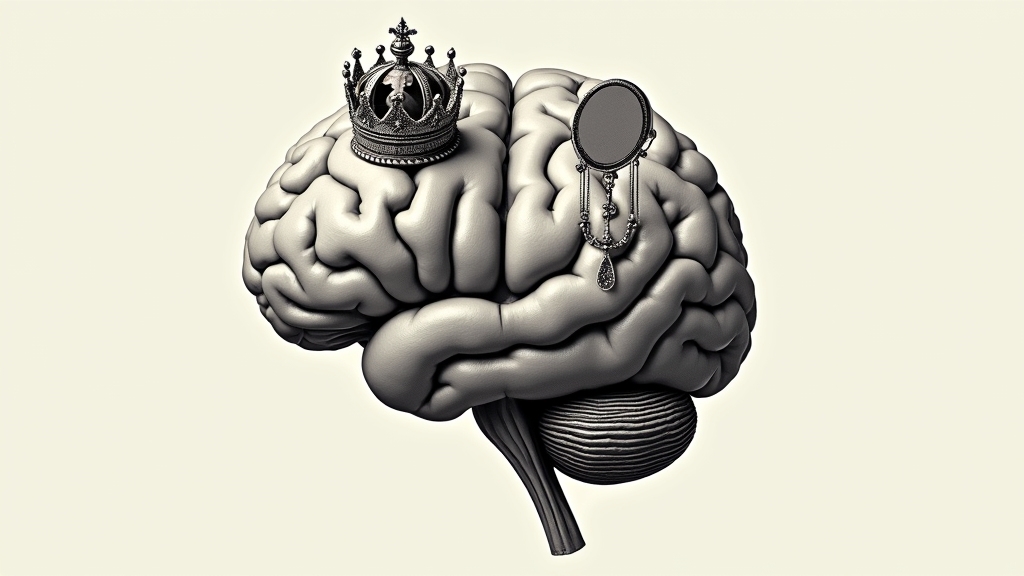I’ve spent years navigating the confusing and often painful world of emotionally complex relationships—some with people who seemed narcissistic, others who were just deeply emotionally unavailable. For a long time, I didn’t know how to tell the difference, and it left me feeling lost, second-guessing myself, and blaming my own needs for the dysfunction around me.
It wasn’t until I dove deep into the psychology of narcissism and attachment that I began to see clearly. What I learned changed not only how I relate to others—but also how I relate to myself. That’s why I created this guide: to help you recognize the patterns, protect your heart, and finally find the clarity you deserve.
Whether you’re trying to understand a partner, a parent, or even your own behaviors, this is a safe space for truth, growth, and healing.
🔑 Key Takeaways
- Narcissism exists on a spectrum, ranging from healthy self-regard to the clinical disorder (NPD), and involves a lack of empathy, entitlement, and a need for constant validation.
- Male narcissists often exhibit overt, grandiose behavior—seeking admiration through achievements, dominance, and power. They may react with rage or intimidation when criticized.
- Female narcissists tend to use covert tactics like emotional manipulation, martyrdom, and triangulation. Their need for control often hides behind caregiving or victimhood.
- Avoidant attachment is not narcissism. While it may look similar—emotional distance, withdrawal, discomfort with intimacy—it stems from fear and self-protection, not entitlement or manipulation.
- Empathy is the major differentiator: Narcissists lack genuine empathy; avoidantly attached people have it but struggle to express it under stress.
- Motivations differ: Narcissists seek admiration and control; avoidants seek emotional safety and autonomy.
- Mislabeling these patterns can lead to relationship harm: Strategies that work with avoidant individuals (patience, emotional safety) can enable narcissists, and vice versa.
- Society reinforces gendered narcissism: Men are encouraged to be dominant and successful, while women are taught to prioritize relationships and emotional caretaking—shaping how narcissism is expressed and often overlooked.
- Healing is possible: Avoidant attachment can improve with therapy and emotional work. Narcissism, especially NPD, is harder to change and often resistant to self-awareness.
- Self-reflection is essential: Recognizing your own patterns—whether avoidant or narcissistic—can break cycles and lead to healthier, more secure relationships.
“My ex-husband would rage when I asked about finances, while my friend’s ex-wife silently punished her for days after criticism.” Both were narcissists with completely different behaviors. Today, I’m breaking down how narcissism manifests differently in men versus women – and why people often mistake avoidant attachment for narcissistic traits.

Have you wondered if someone in your life is narcissistic or just emotionally unavailable? This article will provide the clarity you’re seeking. I’ll share my own journey navigating these relationships, explore the specific patterns, unpack the psychological roots, and equip you with powerful tools to protect yourself in either situation.
Understanding Narcissism: The Basics
Before we go deeper into gender differences, let’s get clear on what narcissism actually is. Narcissism isn’t just a label for someone who takes too many selfies or talks about themselves a lot. It’s a specific pattern of behaviors centered around an excessive focus on oneself at the expense of others. This distinction matters because it helps us identify these patterns in our relationships.

Many people don’t realize there’s a big difference between having some narcissistic traits and having Narcissistic Personality Disorder. We all have moments of self-centeredness or wanting validation – that’s normal and human. NPD, however, is a clinical diagnosis that affects only about 1-3% of the population. It involves a pervasive pattern of grandiosity, need for admiration, and lack of empathy that causes significant problems in many areas of life.
Think of narcissism as existing on a spectrum. On one end, you have healthy self-confidence and self-care. As you move along the spectrum, you encounter increasing levels of narcissistic traits until you reach the far end where NPD exists. Most people you encounter with narcissistic behaviors won’t have the full disorder – but their traits can still cause real harm in relationships.

Regardless of gender, all narcissists share certain core characteristics. The first is a profound lack of empathy – a genuine inability to understand or care about others’ feelings unless they directly impact the narcissist. Many narcissists can seem attentive when it serves them, but this is strategic rather than genuine. Second, they display an underlying sense of entitlement – believing they deserve special treatment or recognition without earning it. This entitlement often coexists with surface-level charm or apparent humility. Third, narcissists have an insatiable need for validation or “narcissistic supply” – a constant need for admiration and confirmation of their specialness that drives most of their behavior. When this supply is threatened, they typically react with rage, manipulation, or emotional withdrawal.
Consider this example that illustrates the difference between everyday narcissistic moments and clinical narcissism: Someone posts a photo on social media and checks frequently for likes – that’s normal behavior today. But imagine that same person becomes visibly upset when their post doesn’t get enough attention, questions their friendships, creates drama to regain attention, and shows no concern for how their reaction affects others. That pattern suggests concerning narcissistic traits.

Understanding narcissism matters more today than ever before. We live in a culture that often rewards narcissistic behaviors, especially in professional settings. The confident self-promoter often gets the job over the quiet competent worker. Our social media platforms are designed to reward self-promotion and image cultivation. These cultural factors don’t create narcissism, but they provide fertile ground for narcissistic traits to flourish and be rewarded.

In professional environments, narcissistic traits can actually help people advance – at least initially. The self-confident presenter who takes credit for team successes might get promoted faster than the collaborative team player. The manager who makes bold decisions might be seen as visionary rather than reckless. This societal reinforcement makes it harder to identify these patterns as problematic.
A common misconception about narcissism is that it always looks like obvious arrogance. In reality, narcissism wears many masks. Some narcissists present as vulnerable, victimized, or even selfless helpers. What matters is the underlying pattern of empathy deficit, entitlement, and excessive need for validation – not the specific presentation.
Another misconception is that narcissists don’t experience insecurity. Most narcissistic behaviors actually stem from deep insecurity that the person finds intolerable. The grandiosity serves as protection against these painful feelings. Many narcissists aren’t fully aware of their manipulation; their distorted view of themselves and others feels completely normal to them, which is why these patterns resist change.

It’s important to understand that narcissism isn’t a simple character flaw someone can decide to fix. These patterns typically develop from complex childhood experiences where a child either received excessive praise without substance, or faced severe criticism or neglect. This developmental aspect explains why true narcissism is difficult to treat – these aren’t just bad habits but fundamental ways the person experiences themselves and the world.
Narcissism can look like extreme confidence in one person and like insecurity in another. Some narcissists are obviously grandiose, while others appear shy or self-deprecating. What unites them is that the focus remains on their needs, regardless of specific behaviors.

When dealing with someone with strong narcissistic traits, genuine connection feels impossible. Conversations repeatedly turn back to them. Your feelings consistently take a backseat to theirs. After spending time with them, you might feel drained, confused, or diminished – emotional effects that serve as important clues when the behaviors are hard to pinpoint.

While these are the universal aspects of narcissism, the expression of these traits often follows gender lines due to socialization from childhood. Men are typically socialized to value power, achievement, and dominance, while women are often socialized to value relationships, caregiving, and emotional connection. These different socialization patterns create distinct manifestations – a narcissistic man might display power and success, while a narcissistic woman might weaponize relationships and emotional caretaking. This gendered expression creates recognition problems, as male patterns align with our cultural image of narcissism, while female patterns often fly under the radar. Let’s explore these gender differences to help you recognize them in your own relationships.
The Male Narcissist: Classic Presentation
When most people picture a narcissist, they’re imagining a man. Specifically, they’re thinking of what psychologists call the grandiose narcissist – someone who commands attention when they enter a room, talks loudly about their achievements, and seems absolutely convinced of their own superiority. There’s a reason this image comes to mind. Male narcissism often presents in this very recognizable form.
Think about the loud guy at the party who somehow turns every conversation back to himself. Or the coworker who spends meetings showcasing his brilliance while dismissing everyone else’s ideas. This classic presentation of male narcissism is usually easy to spot because it often aligns with what society already expects from successful men. The behaviors might be extreme, but they’re following a script our culture has written about masculine achievement and dominance.

Our society has specific expectations about how men should behave. They should be confident, assertive, and focused on success. They should compete and win. They should be in control of their emotions and situations. These aren’t inherently bad traits, but for men with narcissistic tendencies, these social expectations provide the perfect cover. A man who constantly brags about his achievements is seen as “confident” according to social norms. A man who dominates conversations is viewed as “assertive” as men are encouraged to be.
Look at how we raise boys. We tell them not to cry, to toughen up, to be the best. We reward them when they win and often show disappointment when they display vulnerability. This socialization creates fertile ground for narcissistic traits to develop. The same behaviors that might be labeled problematic in girls – being bossy, demanding attention, showing off – are often praised in boys as signs of leadership potential and healthy confidence.
Consider what happened in a marketing meeting I recently observed. When Sarah presented her campaign ideas, Mark interrupted repeatedly, speaking over her with statements like “What we really need to do is…” and “Let me explain how this works.” He referenced his past successes constantly, mentioning clients by name and dropping industry awards he’d won. When the team leader asked for feedback, Mark dominated the conversation, dismissing others’ concerns while positioning himself as the expert. After receiving mild criticism about his approach, he immediately pointed out flaws in everyone else’s work before storming out of the room. This single meeting showcased several classic male narcissistic behaviors: conversation domination, status signaling, expertise claiming, and inability to handle criticism.

When dealing with male narcissists, you’ll notice specific patterns. They name-drop important people and center stories around status symbols – expensive possessions, exclusive experiences, important projects. In groups, they position themselves as experts on all topics, changing the subject if they can’t dominate the discussion. Their language reveals them too – excessive “I” statements, constant interruptions, and questions designed to redirect attention to themselves.
Criticism threatens their carefully constructed self-image. Male narcissists typically respond with rage, dismissal, or counterattack. Beneath their confident exterior lies profound insecurity. Any suggestion of imperfection feels like an attack on their entire identity. They lack the emotional tools to process criticism constructively because they’ve spent a lifetime avoiding genuine vulnerability.
Male narcissists have a distinctive relationship with professional achievement. Their career success becomes their primary source of validation and identity. Job titles, income, and business accomplishments form the core of how they measure their worth, explaining why they often prioritize work above everything else. A promotion proves their superiority, while being passed over feels like a personal attack they might rage about for years. Colleagues become either useful tools or competitors to defeat.
This focus on external validation explains why many male narcissists lose their identity after retirement or job loss. Without that validation, they often don’t know who they are, leading to depression or intensified narcissistic behaviors elsewhere.

In relationships, male narcissists approach partners as achievements rather than equal companions. They pursue intensely at first with attention and grand gestures, not because they’re connecting with you, but because winning your affection proves their value. Later, they treat partners as extensions of themselves, controlling appearance, career choices, or social connections because your choices reflect on them.
The “success at all costs” mentality permeates male narcissism. They believe rules don’t apply to them because they’re special or because winning justifies any means. This manifests as ethical corner-cutting, cheating even in minor competitions, or hurting others to achieve goals. This winner-takes-all approach extends beyond work into relationships, parenting, and hobbies, making them difficult partners because compromise feels like losing.
During conflicts, male narcissists typically use intimidation or withdrawal. Intimidation ranges from yelling to subtle status plays that make you feel inadequate. If that fails, many withdraw – giving silent treatment or physically leaving. Both tactics control the situation while avoiding vulnerability or accountability, preventing genuine resolution.
These patterns connect to messages boys receive about emotions and vulnerability. Many learn early that showing sadness, fear, or hurt makes them weak. Without healthy ways to process normal emotions, they develop protective patterns – transforming hurt into anger, focusing on achievement instead of connection, or dismissing emotions entirely.
Understanding these patterns doesn’t excuse harmful behavior but explains why male narcissism takes these forms. Interestingly, female narcissism often manifests quite differently, shaped by distinct social expectations and norms for women’s behavior.
The Female Narcissist: Hidden Patterns
While male narcissism often shows up in obvious ways, female narcissism typically flies under the radar. This isn’t because women are naturally more narcissistic or manipulative – it’s because our society shapes how these traits express themselves. From early childhood, girls receive different messages than boys about acceptable behavior. We’re taught to be nurturing, to prioritize relationships, and to express ourselves through emotional rather than physical means. These expectations create a perfect environment for female narcissism to develop in less recognizable ways.

This is why female narcissism is frequently overlooked or misdiagnosed. When a woman displays narcissistic traits, these behaviors often get labeled as something else entirely – perhaps she’s “emotional,” “sensitive,” or “high maintenance.” In clinical settings, female narcissists might receive diagnoses like borderline personality disorder, histrionic personality disorder, or anxiety and depression. Their narcissistic patterns remain hidden behind presentations that match our expectations of female emotional expression.
Female narcissists typically use three main behavioral patterns that differ from their male counterparts. Think of these tactics as a sophisticated magic show – while you’re focused on the dazzling display of emotion in one hand, the real manipulation happens with the other. The audience never suspects because the performance aligns perfectly with what they expect to see.

The first pattern is covert manipulation – subtle tactics that control relationships while maintaining plausible deniability. A female narcissist might say, “I’m just worried about you wearing that outfit. I wouldn’t want people to get the wrong impression.” This sounds like concern but functions as control. When challenged, she responds, “I was just trying to help! Why are you so sensitive?” This plausible deniability makes her manipulation particularly effective.
The second pattern, emotional martyrdom, involves constantly highlighting sacrifices. “I gave up my career for this family, and this is how you thank me?” These statements create guilt and obligation, keeping others trapped in a cycle of trying to repay an emotional debt that can never be satisfied.

The third pattern, competitive victimhood, redirects every conversation about others’ struggles to the narcissist’s greater suffering. If you mention having a rough day, she immediately responds with her worse experience. This consistent pattern of one-upping others’ pain maintains her victim status.
When faced with criticism, female narcissists typically respond with emotional withdrawal and the silent treatment rather than rage. This emotional abandonment serves as punishment and creates anxiety in others, who often end up apologizing even when they’ve done nothing wrong.
Female narcissists excel at creating relationship dynamics that maintain their control. Triangulation is common – they tell you what others supposedly said about you, pit people against each other, or bring in outside opinions to validate their position. They also employ loyalty tests to ensure they remain central in relationships, from sharing false secrets to creating arbitrary rules to test commitment.
Unlike male narcissists who often seek validation through professional achievements, female narcissists typically focus on appearance, relationships, or caregiving roles. Their physical attractiveness might become an obsession. Their relationship status offers external validation. Or they might build their identity around being the perfect mother, friend, or volunteer – not from genuine care, but because these roles provide recognition.

Female narcissists typically excel at behind-the-scenes control tactics. While male narcissists might dominate a meeting openly, female narcissists work through whispered comments, private messages, and social manipulation. They might spread “concerns,” sabotage others while appearing helpful, or create complex situations where others end up fighting while they appear uninvolved.
One distinctive feature of female narcissism is how they weaponize emotions. Society expects women to be emotional and gives them more freedom to express feelings openly. Female narcissists exploit this expectation strategically. Tears emerge precisely when they’re being held accountable. Expressions of hurt feelings derail conversations about their behavior. Emotional fragility becomes both shield against criticism and weapon of control.
This emotional manipulation is effective because it leverages societal conditioning. When a woman cries or expresses hurt, our instinct is often to comfort rather than continue a difficult conversation. This gives female narcissists a powerful tool for avoiding accountability.

Many female narcissists present as “communal narcissists” – individuals who gain narcissistic supply through being seen as helpful or caring. They volunteer for every committee, donate publicly, and showcase their generosity on social media. Behind this helping facade lies the same need for admiration and lack of empathy that defines all narcissism.
All these patterns connect directly to societal messaging girls receive. From early childhood, many girls learn that direct power-seeking is inappropriate. Instead, they’re taught their value lies in relationships, appearance, and caregiving. For girls with narcissistic tendencies, these lessons don’t eliminate their need for control – they redirect how they seek it.
Research shows that while men typically score higher on grandiose narcissism, women often score higher on vulnerable narcissism – focusing on hypersensitivity to criticism and emotional reactivity while maintaining entitlement and lack of empathy.
Understanding these patterns doesn’t mean all emotional or helpful women are narcissists. Most women express emotions and help others genuinely. The difference lies in consistent patterns, underlying motivation, and impact on others. When relationships consistently leave others feeling confused, diminished, and emotionally drained, narcissistic dynamics may be at play – regardless of how they present.

Avoidant Attachment: What It Really Is
Now that we understand how narcissism presents differently in men and women, let’s talk about something that often gets confused with narcissism – avoidant attachment. This confusion happens all the time in relationships, and mistaking one for the other can lead you down completely different paths.
Attachment theory gives us a framework for understanding how our early relationships shape our adult connections. This theory identifies four main attachment styles: secure, anxious, avoidant, and disorganized – patterns that form in childhood based on how caregivers responded to our needs.

Secure attachment develops when caregivers consistently meet a child’s emotional needs. Anxious attachment forms when caregiving is inconsistent. Disorganized attachment results from frightening caregiving. Avoidant attachment typically develops when a child’s emotional needs are consistently dismissed or ignored.
Imagine a child who cries and reaches for comfort, only to be told, “Stop crying, you’re fine,” or “Don’t be so sensitive.” Over time, this child learns that expressing needs leads to rejection. The lesson becomes clear: rely on yourself and keep your emotions hidden.
This childhood experience creates the foundation for avoidant attachment in adulthood. When emotional expression isn’t safe in your formative relationships, you develop protective strategies. You learn to suppress feelings, maintain emotional distance, and prioritize self-reliance.

The core characteristics of avoidant attachment include fear of intimacy, need for independence, and emotional distance in relationships. These aren’t manipulative tactics – they’re deeply ingrained survival mechanisms that helped protect the person in childhood.
People with avoidant attachment often appear extremely self-sufficient. They pride themselves on not needing others and may look down on emotional expressiveness. This happens because emotional independence feels safe while needing others feels dangerous based on their earliest experiences.
In relationships, avoidant attachment creates what therapists call the push-pull dynamic. As intimacy increases, the avoidant person experiences discomfort – feeling suffocated when someone gets too close. Their nervous system signals danger, prompting them to create distance through working longer hours, picking fights, or emotionally withdrawing.

One client described this perfectly: “When my wife starts opening up about relationship issues, I physically feel like I need to escape. Last week, she wanted to discuss our future plans, and I immediately suggested we talk about it ‘later’ after I fixed something in the garage. I wasn’t trying to dismiss her – I was drowning in panic and needed space to breathe. She felt rejected, I felt overwhelmed, and we ended up further apart.”
This distance often triggers anxiety in their partner, who then pursues closeness more intensely. The more the partner pursues, the more overwhelmed the avoidant person feels, creating a cycle that leaves both people frustrated.
When faced with emotional vulnerability, avoidant individuals typically respond through withdrawal or distraction. These responses aren’t calculated attempts to hurt their partner – they’re protective mechanisms activated by emotional discomfort.
This brings us to a crucial distinction: avoidant attachment is fundamentally a protective mechanism, not a manipulative strategy. Avoidant individuals seek safety, not control. They’re trying to feel secure in a world where emotional closeness has historically felt dangerous. Their behaviors aim to protect themselves from perceived threats to their independence.
Unlike narcissists, avoidant individuals have empathy – sometimes profound empathy. They understand others’ feelings but struggle with expressing this empathy effectively, especially during emotional intensity. When emotions rise, their self-protective systems activate, making it difficult to stay responsive.
Many avoidant individuals feel emotions internally but struggle to show them externally. They might feel concern for a partner’s distress but appear detached because they don’t know how to express feelings safely. This disconnect creates relationship challenges and often leaves partners feeling unseen.

The good news is that avoidant attachment responds well to therapy. Unlike narcissistic personality disorder, avoidant patterns can shift substantially with the right support. Therapy can help avoidant individuals understand their patterns, develop emotional awareness, and build tolerance for intimacy.
This healing potential exists because avoidant attachment isn’t about lacking empathy. It’s about fear and protective patterns that can be addressed through safe relationships and support. With patience, many avoidant individuals develop more secure attachment patterns over time.
On the surface, avoidant attachment can look similar to narcissism. Both involve emotional distance and behaviors that hurt partners. Both can leave loved ones feeling unimportant. But these similarities are superficial. The underlying motivations are completely different.
Avoidant individuals distance themselves because closeness threatens their sense of safety. Narcissists distance themselves because intimacy threatens their self-image and exposes insecurities. Avoidant individuals want connection but fear it simultaneously. Narcissists want admiration but aren’t interested in genuine connection requiring vulnerability.
Most importantly, avoidant attachment is about self-protection, while narcissism is about self-elevation. The avoidant person seeks safety. The narcissist seeks superiority or punishes others for inadequate admiration. This difference in motivation creates entirely different possibilities for healing.
Understanding these differences matters in real relationships. With an avoidant partner, creating safety and building trust can lead to meaningful change. With a narcissistic partner, those approaches often lead to greater exploitation.
You might wonder if you have avoidant tendencies yourself. Many people do – especially those raised in families where emotions weren’t welcomed. Recognizing these patterns isn’t shameful but an opportunity for growth. Understanding your attachment style provides a roadmap for developing fulfilling relationships through self-education, therapy, or practicing emotional openness with safe people.
What matters most is approaching these patterns with compassion rather than judgment. Attachment styles aren’t character flaws but adaptive responses to our environments. With awareness and support, these patterns can change, opening the door to deeper connection.
Key Differences: Narcissism vs. Avoidant Attachment
Now that we understand what narcissism and avoidant attachment look like separately, let’s talk about how to tell them apart. This confusion happens all the time in relationships, and getting it wrong can send you down completely different healing paths.
The most fundamental difference between narcissism and avoidant attachment is how they relate to empathy. Narcissists have a genuine lack of empathy – they simply don’t have the capacity to truly understand or care about your feelings unless those feelings directly affect them. They might pretend to care when it serves their needs, but that care isn’t genuine. In contrast, avoidant individuals actually have empathy – sometimes quite deep empathy – but they suppress their emotional connections because feelings scare them. One client with avoidant attachment told me, “I feel everything so intensely that I have to shut down or I’ll be overwhelmed.”

Think of these patterns as two entirely different defense mechanisms. A narcissist is like a fortress with high walls and an aggressive army that attacks anything threatening its image of greatness. An avoidant person is more like a submarine that dives deep underwater when danger approaches – not to attack, but to disappear until the threat passes.
The core motivations driving these patterns reflect this difference:
- Narcissists seek admiration and validation. They need you to think they’re special, exceptional, better than others. Their behaviors – whether charming or cruel – serve this need for superiority.
- Avoidant individuals seek safety. Their emotional distance isn’t about feeling superior – it’s about protecting themselves from what feels like the danger of emotional closeness. They’re trying to keep themselves safe from being hurt.
These differences manifest clearly in how they handle criticism:
- Narcissists respond with rage, defensiveness, or emotional collapse when criticized. They might scream at you, tear you down to build themselves back up, or act completely devastated to make you feel guilty.
- Avoidant individuals typically withdraw or dismiss criticism. They might change the subject, suddenly need to work late, or simply shut down emotionally because criticism triggers their fear of rejection.
Their relationship patterns follow these same distinct tracks. Narcissists exploit others through manipulation, control, and sometimes “love bombing” to create quick, intense connections serving their need for admiration. They charm you early on, make you feel special, then withdraw that charm when you don’t provide enough validation. Avoidant individuals maintain emotional distance throughout relationships, creating a push-pull dynamic where they want closeness but fear it simultaneously. They consistently need space and struggle with deep intimacy as a way to manage their overwhelming fear of being consumed.

The way they manipulate situations also differs significantly. Narcissists manipulate for personal gain using tactics like gaslighting, charm, and guilt to maintain control. They might tell you “You’re too sensitive” or “That never happened” to make you doubt your reality. Their manipulation aims to get what they want while keeping you confused and dependent. Avoidant individuals don’t typically manipulate for gain – they withdraw for protection. Their emotional distance isn’t strategic; it’s a defense mechanism. They might avoid conflict by shutting down, but this isn’t to control you – it’s to protect themselves from emotional flooding.
Self-awareness separates these patterns as well:
- Narcissists usually lack insight into their behavior. They rarely recognize how they affect others or acknowledge vulnerabilities, typically believing problems are always caused by other people.
- Avoidant individuals often recognize their patterns of withdrawal. They may not know how to change these patterns, but they can often admit they exist. Many will tell you directly, “I know I pull away when things get too close.”
The childhood origins create different core wounds. Narcissism often develops from inconsistent validation – where children are sometimes treated as special, but other times emotionally neglected. This creates an inflated self-image covering deeper inadequacy. Avoidant attachment typically comes from early experiences of rejection or emotional intrusion – having caregivers who were emotionally unavailable or dismissed feelings. These different origins mean narcissists fear being ordinary, while avoidant individuals fear being consumed or abandoned.

These differences affect how each pattern responds to therapy. Narcissism, especially at the personality disorder level, is resistant to change. Real change requires acknowledging behavior and taking responsibility – something threatening their entire self-concept. Avoidant attachment can improve significantly with support. Since avoidant individuals often have awareness of their patterns and possess the capacity for empathy, they can gradually learn to tolerate more emotional closeness with compassionate help.
This is why mistaking one pattern for the other leads to completely different relationship strategies. If you’re dealing with an avoidant partner, creating safety and giving space while slowly building trust can lead to meaningful connection. With a narcissist, these same approaches often lead to exploitation as they take advantage of your patience without real change. Similarly, the firm boundaries that might protect you with a narcissist could unnecessarily push an avoidant partner away when they might have been capable of growth.
I’ve seen many people waste years trying to create emotional intimacy with narcissistic partners using strategies meant for avoidant attachment. I’ve also seen people give up on relationships with avoidant partners who genuinely cared for them because they mistakenly believed they were dealing with narcissism.

The bottom line: narcissism and avoidant attachment might look similar on the surface, but they come from completely different places. One stems from a fundamental lack of empathy and need for admiration; the other from fear and self-protection. Recognizing which pattern you’re dealing with – whether in a partner or yourself – is the first step toward finding the right path forward.
Red Flags: Male vs. Female Narcissism
Before we look at gender-specific warning signs, let’s talk about the red flags that show up in all narcissists. Regardless of gender, narcissists share certain core behaviors. They make everything about themselves, turning even your accomplishments or struggles into opportunities to center their own experiences. They use others for their own gain, lack genuine empathy, rarely apologize sincerely, and cannot handle criticism. When criticized, they either rage, dramatically collapse, or make you the villain. Their fragile self-image causes extreme sensitivity to perceived slights, and they consistently violate boundaries, responding with confusion or irritation when you establish healthy limits.
Now let’s explore how narcissism typically presents in men. Excessive competitiveness stands out as a major red flag. Everything becomes a competition – sports, career achievements, even parenting. I worked with a client whose husband turned their child’s birthday party into a competition with other fathers about who could build the better backyard obstacle course. What should have been a fun family event became all about proving his superiority.
Status obsession is another warning sign. Male narcissists prominently display status symbols – expensive watches, luxury cars, prestigious job titles – as central to their identity. They constantly name-drop and mention impressive places, even when irrelevant. This extends to their partners, whom they often treat as trophies while showing little interest in their thoughts and feelings.

Their rage responses can be particularly alarming when they don’t get their way. They may yell, physically intimidate, break things, or punish through prolonged silent treatment. One client shared that her narcissistic ex-husband punched a hole in the wall when she bought the wrong brand of coffee. This disproportionate rage over minor issues signals a pattern of using intimidation to maintain control.
Female narcissism often manifests differently. Martyrdom is common – she constantly reminds others of her sacrifices. “After all I’ve done for you” becomes her catchphrase, creating an unpayable debt that keeps others trapped in guilt and obligation. Unlike healthy giving, the narcissistic martyr maintains a mental ledger of every sacrifice to use as ammunition later.
Emotional triangulation appears frequently in female narcissists. They create three-person dynamics, positioning themselves as victim, rescuer, or persecutor depending on what gets them the most attention. They might tell you what others supposedly said about you or bring outside opinions into conflicts to validate their position, keeping everyone confused and defensive.
Competitive victimhood is particularly common. Whatever hardship you experience, they’ve endured worse. This pattern of consistently one-upping others’ suffering maintains their victim status and the attention it brings.
Early in relationships, narcissistic men and women use different tactics. Men typically love-bomb through grand gestures and intense sexual attention – expensive dates, introducing you to important people, making you feel incredibly desirable. Women often love-bomb through emotional intimacy and caretaking, positioning themselves as your perfect match who understands you completely, creating intense closeness prematurely.

Their treatment of service workers reveals much. Narcissistic men often openly demean servers or employees – speaking condescendingly or becoming enraged over minor mistakes. Female narcissists typically maintain a pleasant public facade while making cutting remarks privately or reporting “problems” to managers. Both demonstrate their belief that certain people don’t deserve basic respect.
When thwarted, their responses often follow gender lines. Men typically become overtly controlling or intimidating, while women more often use emotional withdrawal, silent treatment, or tearful collapse. Both tactics avoid accountability while prioritizing their needs above yours.
Their devaluation tactics differ too. Men often discard partners abruptly, sometimes immediately replacing them publicly to maximize hurt. Women typically engage in behind-the-scenes character assassination, spreading subtle rumors portraying themselves as victims while painting you as unstable or abusive. Both control the narrative to maintain their image at your expense.
Narcissistic parenting shows gender differences affecting children profoundly. Narcissistic fathers often treat children as extensions of themselves, pushing achievements that reflect well on them while showing little interest in the child’s emotional needs. Narcissistic mothers frequently enmesh with children, blurring boundaries by treating them as confidants or emotional supports.
A client shared a telling example: her narcissistic father only attended her basketball games when she was starting player, disappearing when she was benched with an injury. Her friend’s narcissistic mother attended every game but made each one about her own anxiety, requiring her daughter to provide comfort before and after playing. Different behaviors, same self-focused pattern.

Understanding these gender-specific patterns helps you recognize narcissism more quickly. Remember that while these behaviors often fall along gender lines, individual narcissists may show a mix regardless of gender. The key is recognizing the consistent pattern of self-focus, exploitation, and lack of empathy that defines all narcissism.
If you’re seeing multiple red flags in someone you care about, trust your intuition. Your confusion, walking on eggshells, and feeling drained after interactions aren’t accidental. These warning signs exist to help you make informed choices about who deserves your time, trust, and emotional energy.
Societal Factors Shaping Gendered Narcissism
To understand why narcissism looks different in men and women, we need to look at how society shapes us from childhood. Traditional gender roles create distinct paths for narcissistic traits to develop and express themselves. Boys are often raised to be strong, dominant, and achievement-focused. Girls are typically socialized to be nurturing, relationship-oriented, and emotionally attuned to others.

These different expectations start early. Children’s toys communicate powerful messages about worth—boys receive action figures and competitive games emphasizing dominance, while girls get dolls and play kitchens centered on caregiving and social connection. When boys show vulnerability, they’re told to “man up,” teaching them to suppress empathy—the very quality that protects against narcissism. Their value becomes tied to achievement and projecting strength. For boys with narcissistic tendencies, this environment fosters the grandiose presentation we associate with male narcissism.
Girls receive different yet harmful messages. Discouraged from direct power-seeking with comments like “don’t be bossy,” they learn their value comes from relationships, appearance, and caring for others. Girls with narcissistic tendencies develop more covert expressions focused on relational control rather than overt achievement.
Social media has transformed narcissistic expression along gender lines. Male narcissists gravitate toward platforms showcasing achievements and status—posting about accomplishments, important connections, and evidence of expertise or wealth. Female narcissists typically create carefully curated images of physical perfection or relationship success on image-centered platforms. Both seek the same validation, just through different culturally approved channels.

The workplace reinforces these patterns by rewarding different behaviors. Male narcissistic traits like assertiveness and self-promotion are often mislabeled as leadership qualities. A man who dominates conversations might be called “confident” rather than narcissistic. Women face negative reactions for similar behaviors, so female narcissists adapt by using relationship manipulation, presenting as helpful while undermining others, or deploying emotional tactics strategically. These behaviors might be dismissed as “office politics” rather than recognized as narcissism.
Our cultural narratives about “good mothers” versus “successful men” directly shape these expressions. The ideal mother is selfless and devoted; the successful man is achievement-oriented and high-status. These expectations create different acceptable outlets for narcissistic supply.
Female narcissists often use motherhood as a source of validation, presenting as perfect mothers while treating children as extensions of themselves. Their social media becomes a showcase of family perfection, using their maternal role to control children and gain admiration while appearing to fulfill the cultural ideal of sacrifice.
Male narcissists more commonly seek validation through career achievements and public recognition. They pursue prestigious titles, wealth symbols, or authority positions—behaviors society rewards while overlooking the narcissistic motivation. A workaholic who demands recognition might be labeled “dedicated” rather than seen as seeking narcissistic supply.

Generational shifts are emerging in narcissistic expression. Digital natives have grown up with instant validation through likes and followers, creating expressions that sometimes cross traditional gender lines. Young men may focus more on appearance than previous generations, while young women more openly pursue status recognition.
Recent studies indicate narcissism isn’t necessarily increasing but expressing itself in new ways. Constant exposure to curated lives online intensifies narcissistic behaviors in predisposed individuals. The digital persona becomes a powerful tool for validation seeking.
Narcissism intersects with other identity aspects—race, class, sexual orientation—to create varied expressions. A wealthy male narcissist might display status through possessions, while one with fewer resources might focus on physical dominance or sexual conquest. Cultural differences also influence expression; individualistic societies permit overt achievement displays, while collectivist cultures might foster narcissism through claims of exceptional group sacrifice.
These patterns explain why we often miss female narcissism while readily identifying male versions. We’ve been trained to recognize the male presentation as standard, creating confusion when encountering female patterns. Like different dialects of the same language, narcissism adapts to gendered expectations while maintaining its core grammar of entitlement and lack of empathy.

Society enables these behaviors by rewarding their gender-specific expressions—praising men for dominance while admiring women who appear self-sacrificing, even when that sacrifice masks control. By recognizing these patterns, we can create environments that value genuine connection rather than the performances that feed narcissism.

Understanding these societal influences helps explain why identifying narcissistic traits can be so confusing. When you expect narcissism to look like the stereotypical male pattern but encounter its feminine expression, the disconnect can leave you doubting your perceptions—exactly what narcissists count on. Recognizing these variations allows you to make better choices about who deserves your trust and emotional investment, regardless of how skillfully they’ve adapted their narcissism to match societal expectations.
The Confusion Factor: When Avoidants Look Narcissistic
One of the most common confusions I see in my practice is people mistaking avoidant attachment for narcissism. This happens in so many relationships, and it’s easy to understand why. Imagine you’re with someone who constantly pulls away emotionally, rarely shares their feelings, and seems disconnected when you need support. You might wonder: are they narcissistic or just avoidant? This confusion isn’t your fault—these patterns can look remarkably similar from the outside.

I remember working with Melissa, who was convinced her partner Alex was a narcissist. “He withdraws whenever I need emotional support. He changes the subject when I bring up relationship issues. He seems more interested in his hobbies than connecting with me.” These behaviors certainly sound problematic, but they could point to either pattern. Have you found yourself wondering if your partner’s emotional distance means they don’t care about you? Or perhaps you’ve questioned whether their need for space indicates something more concerning about their character? These are exactly the questions Melissa grappled with, and they’re worth exploring in your own relationship.

On the surface, both avoidant individuals and narcissists create emotional distance. Both might pull away during conflict, struggle with vulnerability, prioritize independence, and seem self-focused. The specific behaviors that cause confusion include emotional withdrawal, difficulty with intimacy, and prioritizing personal space over connection. They might avoid deep conversations, respond uncomfortably to your emotions, or withdraw when relationships get too close. When you’re on the receiving end, the emotional impact feels similar—rejection, loneliness, and a sense that your needs don’t matter.
Stress and relationship pressure make these similarities even more pronounced. When an avoidant person feels pressured—perhaps you’ve been asking for more commitment or emotional openness—their avoidant traits intensify as a protective response. This amplification under stress can make them appear more narcissistic, creating further confusion.

The critical difference lies in the intention behind these behaviors. Avoidant individuals withdraw to protect themselves from the vulnerability of emotional closeness. They’re trying to keep themselves safe from what feels threatening. Narcissists create distance to maintain control, feed their sense of superiority, or punish you for not providing enough admiration. One comes from fear; the other from a desire for power.
Think of an avoidant person’s withdrawal like fog rolling in—it’s a natural response to certain conditions, creating distance as a protective blanket. The fog isn’t intentionally hiding the landscape; it’s simply responding to temperature changes. A narcissist’s silent treatment, however, is more like a calculated rainstorm—deliberately unleashed to erode your confidence and wash away your boundaries. While both create distance, one is a defensive reaction while the other is an offensive strategy.

During silent treatment, an avoidant person is experiencing internal distress—anxiety, emotional flooding, or confusion about how to respond. A narcissist’s silence is purposeful punishment. They’re aware their silence hurts you, and that’s the point. They want you to feel the pain of their disapproval so you’ll work harder to please them.
Avoidant individuals often seem self-centered when they’re actually just overwhelmed. When emotional demands feel intense, they focus on self-preservation. They might dismiss your feelings not because they don’t care, but because acknowledging your emotions requires facing their own discomfort. This differs fundamentally from narcissistic entitlement and lack of empathy, though both create similar feelings of being unseen in relationships.
Misdiagnosing avoidant attachment as narcissism harms the healing process. If you approach an avoidant partner with strategies designed for narcissism—like rigid boundaries or confrontational communication—you’ll likely trigger more withdrawal and confirm their fears that emotional closeness isn’t safe. Conversely, if you mistake a narcissistic partner for someone with avoidant attachment, you might keep trying to create emotional safety with someone fundamentally uninterested in mutual vulnerability.
How can you tell the difference? Pay attention to patterns over time, not individual incidents. Notice how the person responds when you’re vulnerable. An avoidant person might seem uncomfortable but show signs of caring, even if they don’t respond effectively. A narcissist typically shows irritation, dismissal, or uses your vulnerability against you later.
Look at their relationships with others. Avoidant individuals usually have a few close, long-term relationships where they show care and consideration. Narcissists tend to have a trail of damaged relationships, frequent conflicts, and discarded people who were no longer useful.

Notice their capacity for genuine interest in others. Avoidant people often show curiosity and care about others’ well-being, even inconsistently. Narcissists typically only show interest when it serves them or presents an opportunity to talk about themselves.
Each type requires completely different strategies. With avoidant partners, creating emotional safety, respecting their need for space, and gradually building trust can lead to growth and deeper connection. With narcissistic partners, strong boundaries, limited emotional investment, and understanding their inability to truly see you are necessary.
Accurate identification matters because it leads to different paths forward. If you’re with an avoidant partner who has capacity for empathy and growth, patience might lead to a fulfilling relationship. If you’re with a narcissistic partner, that same patience often leads to years of emotional abuse and diminished self-worth.
By understanding these differences, you can make informed choices about your relationships. You can recognize whether you’re dealing with someone who’s scared of connection but capable of it, or someone fundamentally unable to form genuine emotional bonds.
Healing Strategies: Dealing with Narcissism vs. Avoidant Attachment
Now that we understand the differences between narcissism and avoidant attachment, let’s talk about how to actually handle each situation. You need completely different approaches for these patterns because they come from different places. What works for an avoidant partner can actually make things worse with a narcissist, and strategies for narcissists can damage potential growth with an avoidant.
When dealing with a male narcissist, you need strong, clear boundaries that specifically address their manipulation tactics:
- Stay firm without engaging in power struggles
- When he tries to dominate conversations, calmly state: “I need to finish my thought before moving on”
- When he dismisses your feelings, respond with: “My feelings are valid whether you understand them or not”
- Document everything to protect your sense of reality (texts, emails, notes with dates)
- Prepare for potential rage responses with a consistent plan (leaving the room or pausing the conversation)
For female narcissists, boundary approaches need adjustment as they often use emotional manipulation rather than direct intimidation:
- Respond to victim-playing with neutral compassion: “I hear you’re upset. I still need to take care of my own needs here”
- Address triangulation attempts: “I’d prefer we solve this between us rather than involving others”
- Recognize emotional weaponizing (crying when confronted, creating dramatic crises) as control tactics
- Respond to silent treatment by continuing normal activities rather than chasing or apologizing
Communication approaches that work with avoidant partners typically backfire with narcissists. With avoidant partners:
- Create emotional safety to help them open up: “I notice you seem uncomfortable talking about this. We can take it slow”
- Give space during emotional conversations: “I can see this is overwhelming. Let’s take a break and come back to this tomorrow”
- Use non-pressuring invitations: “I’d love to hear your thoughts when you’re ready to share them”
These gentle approaches work because avoidants want connection but fear it. However, narcissists interpret gentleness as weakness and an opportunity to avoid accountability.
To identify whether you’re dealing with narcissism or avoidant attachment, observe these key differences:
After conflicts:
- Avoidant partners withdraw but eventually return to reconnect after processing feelings
- Narcissists expect you to apologize even when they were at fault or act like nothing happened
Treatment of others:
- Avoidant individuals may be uncomfortable socially but treat people with basic respect
- Narcissists charm people with status while dismissing those they deem unimportant
Admitting mistakes:
- Avoidant partners can acknowledge errors with enough safety and time
- Narcissists typically deflect fault, make excuses, or position themselves as victims
Self-protection strategies must differ based on the pattern you’re facing:
With narcissists:
- Maintain emotional distance – don’t share deep vulnerabilities
- Preserve outside relationships and support systems
- Keep separate interests and identity
With avoidant partners:
• Develop internal security rather than requiring constant validation
• Learn to self-soothe when they need space
• Maintain boundaries while understanding their need for independence isn’t personal rejection
Healing paths also differ significantly. After narcissistic relationships, healing involves recognizing the abuse experienced – often subtle and psychological. Working with a therapist who understands narcissistic abuse helps process the gaslighting and manipulation.
After avoidant relationships, healing typically focuses on addressing your own attachment insecurities that were triggered. This involves working through abandonment feelings and developing confidence in your worthiness of love.
When deciding whether to stay or go, consider these factors:
With narcissistic partners:
• Evaluate whether the relationship damages your mental health and self-esteem
• Recognize that relationships with true narcissists rarely improve significantly
• Understand that genuine empathy, necessary for change, is what narcissists fundamentally lack
With avoidant partners:
- Assess their willingness to work on growth together
- Look for recognition of their patterns and efforts toward greater connection
- Consider leaving if they refuse to acknowledge issues or make adjustments
Regardless of your current relationship status, healing your own attachment wounds is crucial. We often gravitate toward familiar patterns even when they cause pain. Working with a therapist helps identify and heal early attachment wounds, developing more secure attachment within yourself.
As you heal, you’ll naturally become less compatible with partners who aren’t doing their own growth work. You’ll begin recognizing healthier relationship dynamics where both people can be vulnerable, make mistakes, repair those mistakes, and grow together.
Healthy relationships feel distinctly different from these patterns. In healthy dynamics, conflict strengthens the relationship through repair. Both people express needs without fear of abandonment or punishment. Mistakes become opportunities for growth rather than sources of shame or power struggles. And most importantly, both people feel more authentically themselves within the relationship rather than diminished, anxious, or confused.
Self-Reflection: Examining Your Own Patterns
Understanding others starts with understanding ourselves. That’s why self-reflection matters so much if you want to break free from unhealthy relationship patterns. Whether you’ve been dealing with narcissistic partners, avoidant ones, or you’re simply trying to create healthier connections, looking at your own patterns is where real change begins.
Let’s explore how to recognize possible narcissistic traits in yourself. Regardless of gender, ask yourself: Do you need to be exceptional in your chosen pursuits? Do you become defensive when criticized? Do you feel constantly underappreciated? Do conversations often revolve around your accomplishments or problems? Do you need to be seen as the most attractive, caring, or put-together person in your circle? Do you feel competitive with friends or family members?

These questions help identify narcissistic tendencies, but having some of these traits doesn’t mean you have a personality disorder. We all experience moments of self-focus. The concern arises when these traits form a persistent pattern that damages your relationships.
For identifying avoidant attachment patterns, consider: Do you withdraw when relationships become too intimate, not to hurt others but because you feel overwhelmed? Do you prioritize independence to the point of refusing help? Do you struggle to discuss feelings because they seem too intense? Do you care about others but freeze during emotional situations? These indicate avoidant attachment—a self-protective pattern different from narcissism. The distinction lies in your capacity for empathy and motivation. Avoidant individuals withdraw for self-protection, not to control or punish others.

Our childhood experiences profoundly shape these patterns. Parents who made your worth contingent on achievements or appearance may have fostered narcissistic traits as your way to feel valued. If love depended on performance, you learned that acceptance was conditional—creating a persistent need to prove yourself. Conversely, if your emotional expressions were consistently dismissed with comments like “stop crying” or “toughen up,” you likely developed avoidant attachment, learning that vulnerability led to rejection.
I remember working with Alex, a successful executive who initially sought therapy because his partners kept leaving him for being “emotionally unavailable.” Through our sessions, he recognized his avoidant patterns stemmed from childhood—his father had ridiculed him whenever he showed “weakness.” The breakthrough came when Alex connected his automatic withdrawal during conflicts to his fear of vulnerability. By practicing staying present during difficult conversations, he gradually built a secure relationship for the first time. “I finally understand that my partner’s emotions aren’t a threat,” he shared after six months. “I can be there for her without losing myself.”
Your attachment style explains your attraction to certain partners. With anxious attachment and fear of abandonment, you might gravitate toward avoidant or narcissistic individuals whose emotional distance feels familiar. The resulting push-pull dynamic may feel like love because it mirrors your early experiences. If you’re avoidant, you might choose partners who demand little closeness, or paradoxically, extremely demanding partners who confirm your belief that relationships are overwhelming.
It’s crucial to distinguish between narcissism and avoidant behavior in partners. Someone who withdraws because they’re emotionally overwhelmed differs from someone withdrawing to punish you. Consider: Does your partner show empathy in other contexts? Do they care about your well-being, even expressed in non-emotional ways? Do they respect boundaries and treat others with kindness? Affirmative answers suggest avoidant attachment rather than narcissism—a distinction that transforms how you approach the relationship.

Healing narcissistic patterns requires courage and commitment. The process begins with developing genuine self-awareness about how your behaviors affect others, often requiring specialized therapy. The journey involves confronting painful feelings of shame or inadequacy beneath narcissistic defenses, learning self-validation instead of requiring external approval, and developing true empathy by recognizing others’ independent needs.
For those with avoidant attachment, healing requires building tolerance for emotional intimacy. This means learning that vulnerability isn’t dangerous in healthy relationships, recognizing your emotions rather than suppressing them, and communicating needs instead of expecting others to intuit them. Small steps make significant progress: try sharing one feeling daily with someone safe, staying present during emotional conversations, and moving toward connection when you notice yourself withdrawing.
Therapy supports healing both patterns, though approaches differ. For narcissistic traits, therapy compassionately challenges defenses while building empathy. For avoidant attachment, therapy creates emotional safety while gradually increasing capacity for vulnerability. Finding a specialist in attachment or personality issues is essential.

Awareness is only the beginning. Recognizing patterns doesn’t automatically transform them but empowers you to make different choices. When you notice yourself slipping into old behaviors, you can pause and choose a new response.
This work demands effort but offers tremendous rewards. As these patterns heal, you’ll discover deeper, more authentic connections and experience the freedom of being your genuine self rather than constantly seeking validation or protection. You’ll find that relationships can provide joy and growth instead of threat or disappointment.
The path to healthier relationships begins with honest self-reflection. By understanding your patterns, you gain the power to create different outcomes. With awareness, support, and practice, you can build the genuine connections you’ve always wanted.
Conclusion
Throughout this article, we’ve seen how narcissism shows up differently in men versus women, while also distinguishing it from avoidant attachment. Male narcissists often display grandiosity and status-seeking, while female narcissists typically use emotional manipulation and relationship control. Avoidant individuals, however, withdraw for protection rather than punishment.
Getting this identification right matters deeply for your healing journey. Different approaches are required for each pattern—what works for avoidant attachment can backfire with narcissism.
As you reflect on your relationships, remember Sarah who found peace after correctly identifying her partner’s patterns. You deserve relationships that feel safe, honest, and genuinely loving—understanding these differences empowers you to create them.
Key Concepts:
- Narcissism Defined:
- Exists on a spectrum from healthy confidence to Narcissistic Personality Disorder (NPD).
- Core traits: lack of empathy, entitlement, and constant need for validation.
- Narcissistic behavior can be grandiose or covert and stems from early childhood wounds.
- Gender Differences in Narcissism:
- Male Narcissists: Often overt, grandiose, status-obsessed, and aggressive in defending their ego. Use professional achievement and dominance to assert superiority.
- Female Narcissists: Tend to manipulate emotionally, use martyrdom, covert control (e.g., triangulation, silent treatment), and emphasize appearance or caregiving roles for validation.
- Avoidant Attachment vs Narcissism:
- Avoidant Attachment: Stems from early emotional neglect. These individuals fear intimacy, value independence, and withdraw when overwhelmed—not to punish, but to protect themselves.
- Narcissists: Seek superiority, manipulate for control, and react with rage or dismissal when criticized.
- Key Differences:
- Empathy: Narcissists lack genuine empathy; avoidants have it but suppress expression.
- Motivation: Narcissists aim for admiration and power; avoidants seek emotional safety.
- Healing: Narcissism is resistant to change; avoidant attachment often improves with therapy.
- Societal Influence:
- Gender norms shape narcissistic expression: boys are conditioned toward dominance and girls toward relational validation and caretaking.
- Social media and cultural roles reinforce narcissistic patterns differently for men and women.
- Red Flags:
- Men: Status obsession, competitiveness, rage when criticized.
- Women: Emotional manipulation, victim-playing, subtle relational sabotage.
- Healing and Strategies:
- Narcissists: Require firm boundaries, emotional detachment, and are often incapable of mutual growth.
- Avoidants: Benefit from emotional safety, patience, and therapy.
- Self-awareness and reflection are crucial for healing your own relational patterns and attachment wounds.










